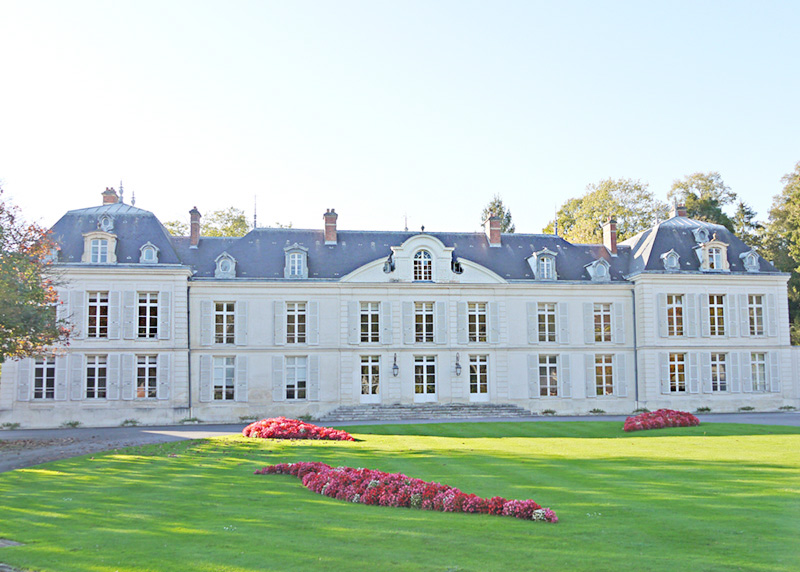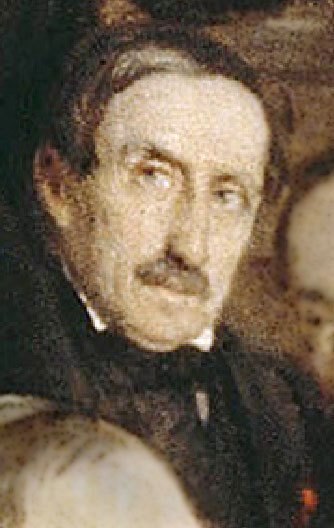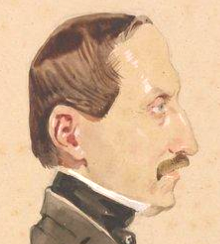Charles O’Hara de Nieuwerkerke (1785-1864), luitenant (father of Èmilien)
1st image: Soirée; 2nd: caricature Giraud (1851); 3rd: drawing by Heim (?)(c.1820)
Charles O’Hara Nieuwerkerke, father of Émilien de Nieuwerkerke16, was born in Lyon in 1789. He was one of two sons of Willem Hendrik (also known as Guillaume-Henry) van Nieuwkerk, himself an illegitimate child of Stadthouder William IV of Orange. Willem Hendrik was strategically positioned outside Holland, serving as vice-consul in Morocco from 1783 to 1793, and briefly as acting consul between 1855 and 1856.
The name "Charles O’Hara" pays homage to an English general of the same name, who immediately became involved in the American Revolutionary War when he landed at Sandy Hook (New Jersey) in 1778, and represented British forces at the surrender dinner with George Washington. Back in Europe, General O’Hara fled England due to gambling debts and immersed himself in aristocratic circles in Paris and Rome. He later became governor of Gibraltar.
A charming and witty man, O’Hara formally registered young Charles in the absence of Willem Hendrik, who at the time was stationed in Larache, near Tangier. The fact that the boy bore none of his father’s given names sparks speculation regarding his parentage —perhaps a continuation of his grandfather’s pattern of discretion. That said, the name Charles did also appear in his maternal lineage.
Unlike his elder brother Guillaume de Nieuwerkerke08, who attended the École Polytechnique and held military posts as a cavalry officer, Charles preferred to display his fine appearance and good manners at the refined life of the Parisian salons. It was in these social circles that, at age 21, he met Louise-Albertine de Vassan (1790–1854), a member of high society and cousin to Count Horace de Viel-Castel43. The couple fell in love, and Charles successfully won her over from her family. There was some haste in marrying her, on October 27, 1810: their son Alfred-Émilien was born five months later.
Echoing family precedent, Émilien’s birth took place in modest surroundings —at the home of an obscure obstetrician in Paris’s working-class Saint-Martin district— while his father was away traveling. He was registered two days later by two local witnesses: a pastry chef and a schoolteacher.

Charles benefited greatly from the prestige and fortune of the de Vassan family. Through their connections, he rose to the rank of lieutenant in the first regiment of grenadiers of the Royal Guard (1815-1819), and gentleman of the king's chamber (1829) to King Charles X.
Following the death of his wife’s aunt from the de Vassan branch, the couple inherited her château in Villiers-du-Marne (now Villiers-Saint-Denis), currently in use as a hospital.
It was in this château, nestled on the western edge of the Champagne region, a wine already synonymous for luxury at the time, where the future intendant of the imperial and Paris museums, supported by Charles’s social polish, now mayor of Villiers-sur-Marne, became the sparkling person that set him in the direction of a brilliant career as the “god-emperor” of the Louvre.
Despite his active social life, Charles was a dedicated family man. He visited the Louvre on February 11, 1851, to check on his son, then ill with fever. That spring, he participated in the vendredi-soirées on March 21 and April 4, including an intimate gathering at Viel-Castel’s atelier, where Eugène Giraud11 (likely puffing his trademark cigar) sketched his caricature. Being Émilien’s father earned him a slightly more prominent position in Une Soirée au Louvre than his uncle08, who's face is partially hidden behind Visconti09.
Charles cared for his wife during her final illness; her death in late November 1854 prompted the temporary suspension of the soirées until the following year.


